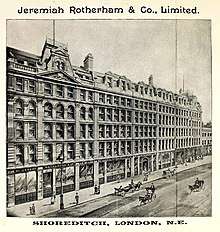Shoreditch High Street
Shoreditch High Street is the old main street of Shoreditch, London. It is part of the A10 road and connects Norton Folgate to the south with Kingsland Road to the north. It constitutes a segment of the Roman Ermine Street, which ran directly north from London to Lincoln and York. The parish church of St Leonard's, Shoreditch is situated at the north-east end of the road, at the crossroads where it meets with Hackney Road. This part of the road is wholly within the London Borough of Hackney; below Boundary Street, the eastern side lies within the London Borough of Tower Hamlets. The high street enters the City of London at Norton Folgate.
.jpg)
In the past, Shoreditch High Street boasted both a prestigious theatre and a music hall, though these are now long gone; no trace survives.
The National Standard Theatre at 2/3/4 Shoreditch High Street opened in 1837. By the late 19th century it was one of the largest theatres in London. In 1926, it was converted into a cinema called the New Olympia Picturedrome. The building was demolished in 1940. Sims Reeves, Mrs Marriott and James Robertson Anderson all performed there; the theatre also hosted programmes of classical opera and even Shakespeare, featuring such luminaries as Henry Irving.
The Shoreditch Empire, also known as the London Music Hall, which opened in 1856, was situated at 95–99 Shoreditch High Street. It lasted longer than most East End halls, but finally closed in 1935.
As it traverses modern-day inner city Shoreditch, the road is lined with (sometimes derelict) commercial premises. To the east is the Boundary Estate, formerly the infamous "Jago" of Arthur Morrison's 1896 novel A Child of the Jago. The concentration of striptease pubs located along the road continues the local low-life tradition, though the recent opening of some trendy bars that cater to the affluent residents of nearby Hoxton indicates the arrival of gentrification in the area.[1]
A large department drapery store called Jeremiah Rotherham & Co once existed in the High Street, taking up the frontage from 80 to 91. The store also purchased the adjacent Shoreditch Empire Theatre in 1934 and built a warehouse on the site. When the main store was destroyed by bombing during the Blitz the company transferred to the new warehouse and reopened.[2]
 Jeremiah Rotherham & Co. Shoreditch High St
Jeremiah Rotherham & Co. Shoreditch High St
References
- Clifton, L. (2002), Baby Oil and Ice: Striptease in East London. The Do-Not Press Limited: London.
- Satisfactory turnover The Guardian London, Greater London, England, 28 Feb 1935, Thu • Page 14